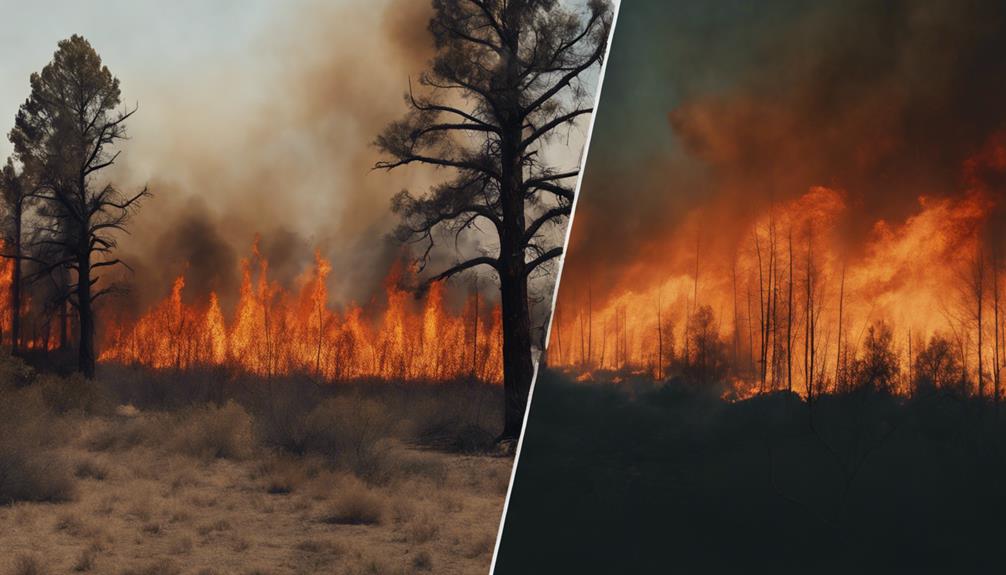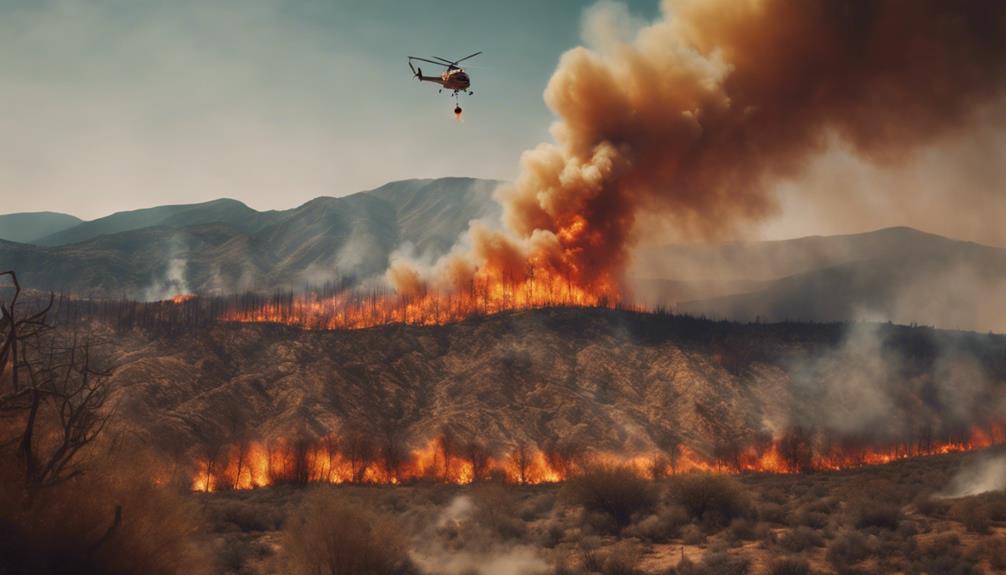When a wildfire sparks, you're likely to encounter spot fires, small, isolated blazes that ignite outside the main fire perimeter, spreading rapidly and unpredictably. These secondary fires form due to strong winds, heat-generated updrafts, and available fuel sources. Spot fires are characterized by intense firebrand generation, influenced by wind direction and fuel types. Understanding spot fires is essential in wildfire management, as they challenge firefighters and require proactive strategies. As you explore spot fires further, you'll discover the complexities of predicting and containing these unpredictable blazes.
Key Takeaways
- A spot fire is a new fire ignited by embers or sparks carried by wind from an existing wildfire, often far from the main firefront.
- Spot fires can spread rapidly, with firebrand generation rates reaching up to 30,000 per square meter per minute.
- Wind patterns, fuel types, and topography influence the spread patterns of spot fires, making them unpredictable and challenging to manage.
- Spot fires can travel significant distances, making them difficult to contain, especially when they start far from the main fire.
- Understanding the factors affecting spot fire behavior, such as wind, fuel, and topography, is crucial for developing effective wildfire management strategies.
What Causes Spot Fires to Form
When strong winds are present, you're likely to see spot fires form ahead of the main firefront, sparked by embers carried aloft by heat-generated updrafts. These updrafts are created by the intense heat emanating from the main fire, which lifts embers into the air, allowing them to travel significant distances.
As these embers are carried away from the main fire, they can ignite new fires in areas with available fuel sources, such as dry vegetation or structures. The importance of spot fires forming increases during high fire danger conditions, characterized by strong winds and dry conditions. In these situations, the risk of spot fires spreading rapidly is heightened, making firefighting efforts more challenging.
Understanding the causes of spot fires is essential for developing effective strategies to combat wildfires. By recognizing the role of wind, heat, and fuel sources in spot fire formation, you can better appreciate the complexities of wildfire behavior and the importance of proactive fire management.
Spot Fire Characteristics and Behavior

As you examine spot fire characteristics and behavior, you'll notice that firebrand generation rate plays a significant role in understanding how these fires spread.
By analyzing spread patterns, you'll see that spot fires can exhibit unique behaviors depending on factors like wind direction and fuel types.
Now, let's take a closer look at these factors and how they influence the development of spot fires.
Firebrand Generation Rate
Spot fires can generate firebrands at an astonishing rate of up to 30,000 per square meter per minute, releasing a barrage of burning embers that can travel far and wide. As you try to comprehend the sheer scale of this phenomenon, it's vital to understand that these firebrands can travel significant distances from the main fire front, igniting spot fires in various locations.
The rate at which firebrands are generated is a critical factor in the spread of wildfires. With winds dispersing these embers, the potential for spot fires to emerge increases exponentially. You'll soon realize that the behavior of spot fires is influenced by wind speed, direction, and the presence of dry fuels. As the firebrands take to the air, the chances of containment dwindle, and the situation becomes increasingly challenging.
It's important to recognize the firebrand generation rate as a key characteristic of spot fires, as it has a direct impact on the overall wildfire management strategy.
Spread Patterns Analysis
You'll notice that the spread patterns of spot fires vary considerably depending on the type of fuel, wind speed, and topography of the area. This variability is important to understand, as it greatly impacts firefighting strategies.
Spot fires can exhibit different spread patterns, igniting in clusters or linearly, making it challenging for firefighters to contain the blaze. The fires can occur simultaneously at varying distances from the main fire, further complicating efforts to combat the flames.
Additionally, spot fire sizes can range from small embers to large flaming fronts, greatly affecting fire behavior. Understanding these characteristics is crucial for predicting fire spread and allocating firefighting resources effectively.
Factors Affecting Spot Fire Spread

As you explore the factors affecting spot fire spread, you'll discover that wind patterns matter greatly, as they can carry embers and sparks far from the main firefront, igniting new spot fires.
The density of fuel loads also plays an important role, as it can either hinder or facilitate the spread of spot fires.
Wind Patterns Matter
Wind direction and speed become critical factors in predicting the trajectory of spot fires, which can ignite new blazes miles ahead of the main firefront. As you try to anticipate the behavior of these unpredictable fires, understanding wind patterns becomes vital.
You'll find that wind patterns greatly influence the spread of spot fires, carrying embers ahead of the main firefront. The erratic and unpredictable nature of spot fire spread is largely due to changing wind directions and speeds.
Firefighters closely monitor wind conditions to adjust containment strategies, as strong winds can cause spot fires to rapidly advance, posing significant challenges in firefighting efforts.
It's crucial to recognize the impact of wind patterns on spot fire spread to assess the risk of new fires igniting in other areas during bushfires. By grasping the role of wind patterns, you'll better comprehend the complexities of spot fires and the importance of adapting to changing wind conditions.
Fuel Load Density
While monitoring wind patterns helps anticipate the trajectory of spot fires, it's equally important to take into account the role of fuel load density in driving their intensity and spread.
As you assess the likelihood of spot fires, consider the amount of fuel available for combustion, known as fuel load density. This factor greatly influences the intensity and spread of spot fires.
In areas with high fuel load density, such as thick vegetation or dense forests, spot fires can develop rapidly and intensely. Conversely, lower fuel load density, like sparse grasslands or cleared areas, may lead to slower spot fire progression.
The type of fuel, including live vegetation, dead plants, and debris, also contributes to fuel load density and spot fire behavior. Understanding variations in fuel load density across different landscapes is essential for predicting and managing spot fire spread.
Challenges in Spot Fire Management

Spot fires pose a significant challenge to firefighters, who must contend with these unpredictable blazes that can ignite new fires in front of the main fire, often traveling considerable distances. As you navigate the complexities of spot fire management, it's essential to understand the factors that affect their behavior. The distance spot fires can travel depends on various factors, including fuel type and weather conditions.
| Factor | Impact on Spot Fire Distance | Firefighter Challenge |
|---|---|---|
| Fuel Type | Dry, fine fuels increase distance | Difficulty containing fires |
| Weather Conditions | Strong winds, high temps increase distance | Anticipating spot fire occurrence |
| Topography | Slopes, valleys affect fire spread | Managing fires in rugged terrain |
| Fire Intensity | High-intensity fires increase distance | Coordinating response efforts |
| Human Factors | Delayed response, inadequate resources increase distance | Strategic planning, quick response |
Firefighters face difficulty containing spot fires due to their ability to start far from the main firefront. Managing spot fires requires strategic planning, quick response, and awareness of fire behavior during bushfire incidents. By understanding these challenges, you can better appreciate the complexities of spot fire management.
Predicting Spot Fire Occurrence

By analyzing fuel moisture content, wind patterns, and topography, you can predict the likelihood of spot fire occurrence, enabling proactive measures to mitigate their impact.
To accurately predict spot fires, you need to take into account multiple factors, including fire weather forecasts and fire danger ratings. These ratings help you understand the likelihood of spot fires based on weather conditions and fuel characteristics.
Advanced spot fire prediction models consider spotting distance, ember production, and firebrand transport, providing a more thorough understanding of spot fire behavior.
Remote sensing technologies, such as satellites and drones, also play an essential role in monitoring fire behavior and predicting spot fire occurrence. Real-time data on weather conditions and fuel characteristics are vital for accurate spot fire prediction.
Strategies for Containing Spot Fires

You can employ various strategies to contain spot fires, including creating containment lines and using heavy machinery to construct firebreaks that stop their spread. Firefighters often utilize existing roads or fire trails as containment lines to halt the advancement of spot fires.
If these natural barriers don't exist, they create their own using heavy machinery like bulldozers and graders. Backburning along these containment lines is a common tactic to reduce fuel and slow the progression of spot fires.
Despite these efforts, embers from spot fires can still jump over containment lines, leading to new spot fires. It's essential to utilize heavy machinery to construct effective containment lines to manage spot fires.
Frequently Asked Questions
What Is the Definition of a Spot Fire?
You're wondering what a spot fire is? Well, it's a new fire ignited ahead of the main fire, caused by embers carried by the wind, and it can start far from the main firefront.
What Is Spotting Fire?
As you wonder what spotting fire is, think of it as a process where new fires ignite ahead of the main firefront, traveling distances away, and sparking new blazes, making firefighting efforts more challenging.
How Is a Spot Fire Ignited?
You might think it's just bad luck, but spot fires aren't just random events – they're actually ignited by embers carried by wind from the main firefront, which can travel long distances to find fuel to ignite.
How Are Forest Fires Spotted?
You're likely to spot forest fires through a combination of ground patrols, aerial reconnaissance, and surveillance systems, as well as reports from the public, firefighters, and lookout towers, allowing for swift response and containment.
Conclusion
As you now understand the complexities of spot fires, it's essential to acknowledge their significance.
Consider this: in 2019, spot fires accounted for nearly 40% of all wildfires in the United States, with an average of 73,000 acres burned per day.
This staggering statistic underscores the importance of proactive management and containment strategies to mitigate the devastating impact of spot fires on ecosystems and human communities.









